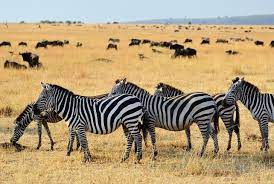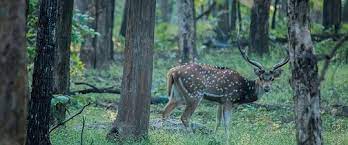It is a consecrated place where sacred species are kept. It is not open for general public, unlike zoo. In other words, we say, it tries not to allow any activity that would place the animals in an unduly stressful situation. India has 543 wildlife sanctuaries.
Characteristics of Wildlife sanctuary
It is natural area which is reserve by a governmental or private agency for the protection of particular species.
Area is designated for the protection of wild animals.
Only animals are conserved, Could be private property also, outside activities allowed.
It came under the category called “Protected Areas”. The Protected Areas are declared under Wildlife (Protection) Act, 1972.
International Union for Conservation of Nature (IUCN) has defined its Category IV type of protected areas.
1. National Park
It is a home to many species of birds and animals which is established by central and state government for the conservation.
Characteristics of National Park
Reserve area of land, owned by the government.
Area is protected from human exploitation, industrialization and pollution.
No cutting, Grazing allowed, Outside Species Allowed.
It came under the category called “Protected Areas”. The Protected Areas are declared under Wildlife (Protection) Act, 1972.
Conservation of ‘wild nature’ for posterity and as a symbol of national pride.
Read Also : Proper Waste Control Complete Guide
International Union for Conservation of Nature (IUCN), and its World Commission on Protected Areas, has defined its Category II type of protected areas.
2. Biosphere Reserves
Biosphere reserves are areas of terrestrial and coastal ecosystems promoting solutions to reconcile the conservation of biodiversity with its sustainable use.
They are internationally recognized, nominated by national governments and remain under sovereign jurisdiction of the states where they are located.
The International Co-ordinating Council (ICC) of UNESCO designated of ‘Biosphere reserve’ for natural areas from November, 1971. There are 18 Biosphere Reserves in India.
Characteristics of Biosphere Reserve
Notified areas which cover a larger area of land which may cover multiple National Parks, Sanctuaries and reserves as well.
Areas are meant for conservation of biodiversity of a specific area.
Three areas: Core, Buffer & Marginal. No outside Species allowed Conservation and research purpose.

It is internationally recognized within the framework of UNESCO’s Man and Biosphere (MAB) programme and nominated by national governments.
The Ministry of Environment and Forest provides financial assistance to the respective State governments for conservation of landscape and biological diversity and cultural heritage.
3. Seed banking
Seed banking is a valuable conservation tool that enables the long-term storage of genetic diversity of a large number of plant species.
It involves collecting, cleaning, drying, recording, and storing seeds at low temperatures for future conservation and restoration uses.
Seed Banking: Steps
- Collecting
- Drying
- Cleaning
- Testing viability
- Storage.
In summary, climate change affects the weather pattern world-wide. This change leads to increase in the average temperature of the earth which has led to loss of biodiversity. Global warming results from human activities through massive burning of fossil fuel leading to the release of greenhouse gases.
Climate change has a huge impact on the normal functioning of the ecosystem. These effect ranges from change in weather pattern, flooding, differential rainfall and disease spread. However, human race is making effort at rolling this menace back through concerted afforestation.
Recent changes in climate have had significant impacts on biodiversity and ecosystems. They have affected species distributions, population sizes, and the timing of reproduction or migration events, as well as the frequency of pest and disease outbreaks.
Global warming has begun to manifest its impact on biodiversity. For instance, of the 95 most common species of passerine birds, those in northern regions are declining the fastest. Biodiversity and climate change are thus connected.
Biological sustainability and animal survival is the ability to maintain ecological processes over long periods of time.
Conservation means the utilization of natural sources in such a way that they are not allowed to destroy. Conservation of biodiversity includes all human efforts to preserve wildlife and plants from extinction as well as wise management of wildlife, plants and their environment.
In-situ conservation means the conservation of species within their natural habitats. This is the most appropriate method for biodiversity conservation. In this strategy you have to find out the area with high biodiversity.
Ex-situ conservation involves the conservation of biological diversity outside of their natural habitats. This involves conservation of genetic resources, as well as wild and cultivated of species, and draws on a diverse body of techniques and facilities.
Read Also : On-site Municipal Wastewaters Treatment
National park is a reserve area of land, owned by the government which is protected from human exploitation, industrialization and pollution; No cutting, Grazing allowed, Outside Species Allowed; it came under the category called “Protected Areas”.
The Protected Areas are declared under Wildlife (Protection) Act, 1972; Conservation of ‘wild nature’ for posterity and as a symbol of national pride.
Biosphere reserves are areas of terrestrial and coastal ecosystems promoting solutions to reconcile the conservation of biodiversity with its sustainable use. They are internationally recognized, and within the frame work of UNESCO.

